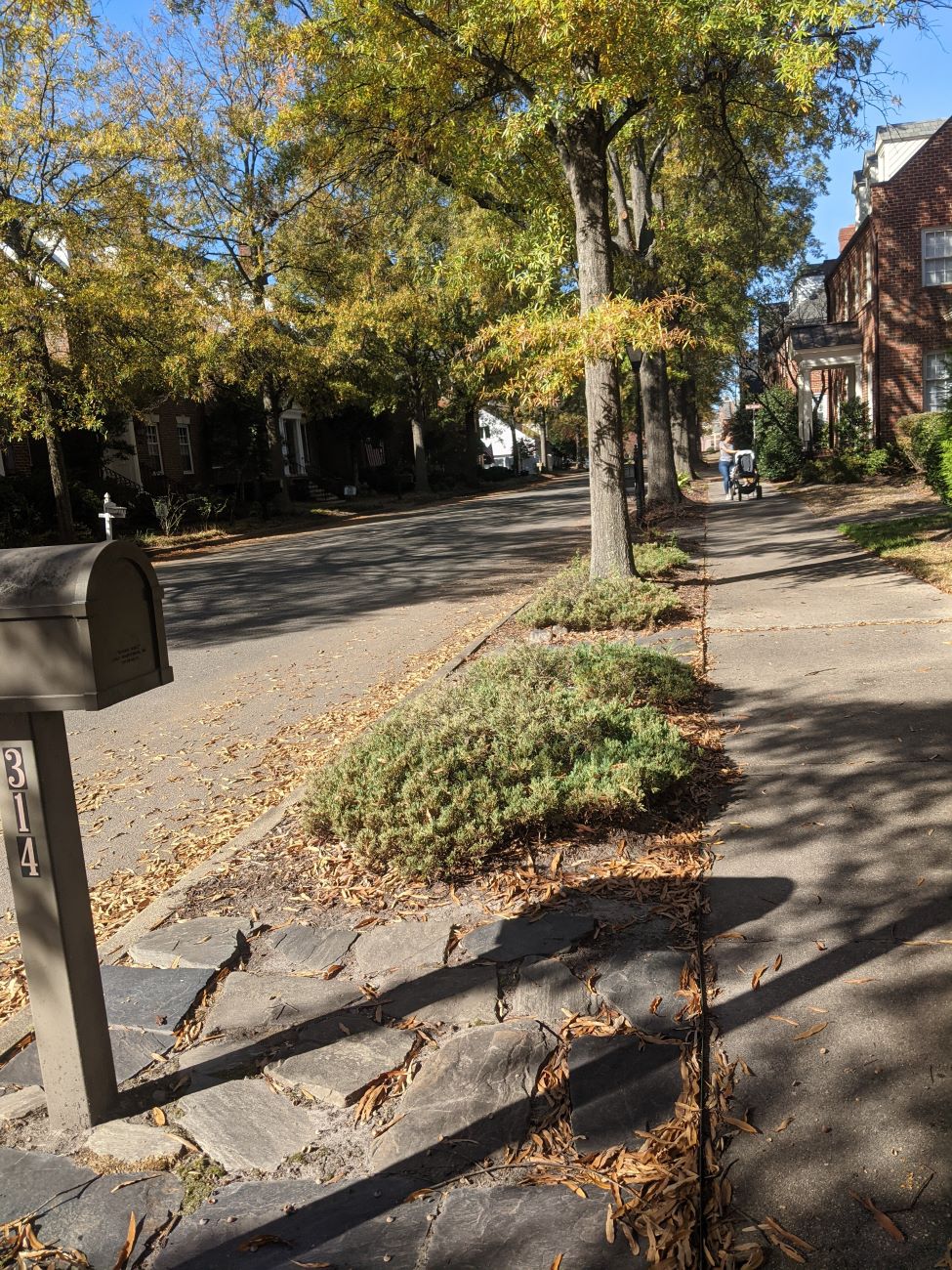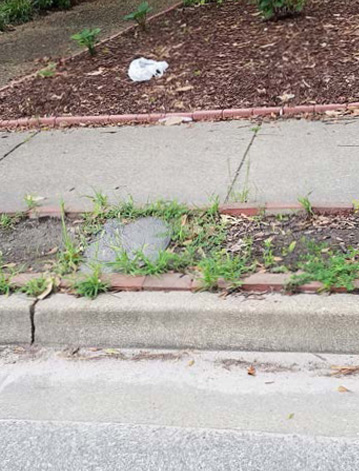LANDSCAPING
Landscape Maintenance
Unlike your fenced-in backyard, landscaping that is visible to the public must conform to a stricter standard of appearance, and changes to these areas require ARB approval.
A homeowner contemplating the modification of landscaping within a publicly visible area must submit a detailed plan, including plant specifications, to the ARB for consideration and approval. In evaluating a proposed Landscape Plan, the ARB will consider whether any of the planned vegetation is liable to create future visibility or sight-line problems for drivers and pedestrians. If this is the expected outcome, or if extensive and frequent trimming will be required to avoid this problem, the ARB may find it necessary to require the applicant to devise and submit an alternative landscape solution.

What's a Verge?
The verge is the area of public land located between the sidewalk and the street. To make the most of these small spaces, one should consider using more appropriate treatments such as turf, reliable and easy to maintain hardscapes and groundcovers or a mixture of perennials and groundcovers, taking care to not place delicate plants where they will be underfoot by passengers emerging from cars.
- The homeowner is responsible for maintaining the verges adjacent to their property.
- The city is responsible for maintaining or removing all street trees in the verge, but all other maintenance responsibilities are the homeowners.
- The residents will need to keep these areas weed free. For a more gardenesque feel with minimal maintenance required, homeowners should consinder using dependable groundcovers (i.e. Liriope spicata, Ophiopogon japonicus).
- Turf in the verges will be the easiest for the homeowner to maintain, unless canopy trees are mature and have shaded and ‘rooted’ out the ground.

Good use of slate
Low maintenance, high visual interest. Good use of stone and maintenance-free mongo grass. Very successful.

Good use of large stone
Well maintained, lush groundcover and low plantings with stone. Larger stone is acceptable but must be a minimum 3-5” diameter.

Good selection of plants
Great selection of low plantings and mulch, well maintained, high visual interest.

Good use of groundcover
Low maintenance, high visual interest. Good use of stone and maintenance-free, low growing shrub.

Good use of large stone
Well maintained, lush groundcover and low plantings with stone, although the shrub should be shorter.

Grass compliments home
Sometimes planting grass in the verge is the easiest, and best option for a clean-looking verge.
Avoid these verge mistakes
Ghent Square residents will often get cited for verges that look unsightly. When redesigning your verge, take care not to use plants that will get too tall and prevent people from exiting their cars on the passenger side. While bare dirt is not acceptable, it’s also worse to completely cover it with mulch. Due to frequent street flooding, mulch gets washed down the street and clogs the drains. If you have too much dirt showing and weeds popping through, you can often solve the problem by planting more low-growing plants such as liriope and putting down more hardscape. Don’t forget to locate all public utility services prior to digging by calling Miss Utility.

Shrubs are too tall

Too much mulch
Avoid covering bare dirt with mulch because it washes down drains. Shrub is too high, will interfere with open car doors. Mound should be reduced and low growing plants should be installed.

Poorly maintained
Avoid poorly maintained verges with no visual interest. Existing stone could remain but would need to be planted with a groundcover.

Avoid sand, not enough plants
Avoid using sand and small pebbles in the verge. The plantings are also too sparse. They should be planted every 12″ and given room to fill in verge.

Don't plant trees in the verge
Only the city of Norfolk should be planting trees in the verge. This tree planted by homeowner obscures the 25 mph speed limit sign.

Keep it simple
Avoid placing pots in the verge and planting shrubs that grow too high, making it difficult for people to open their car doors.
What's a Verge?
The verge is the area of public land located between the sidewalk and the street. To make the most of these small spaces, one should consider using more appropriate treatments such as turf, reliable and easy to maintain hardscapes and groundcovers or a mixture of perennials and groundcovers, taking care to not place delicate plants where they will be underfoot by passengers emerging from cars.
- The homeowner is responsible for maintaining the verges adjacent to their property.
- The city is responsible for maintaining or removing all street trees in the verge, but all other maintenance responsibilities are the homeowners.
- The residents will need to keep these areas weed free. For a more gardenesque feel with minimal maintenance required, homeowners should consinder using dependable groundcovers (i.e. Liriope spicata, Ophiopogon japonicus).
- Turf in the verges will be the easiest for the homeowner to maintain, unless canopy trees are mature and have shaded and ‘rooted’ out the ground.
Maintenance Guidelines
Property owners are required by the City of Norfolk to maintain all landscaping on their property as well as on property outward to the curb-line, whether front, back, or side. Maintenance includes the care of all visible plantings through watering, sweeping, weeding, edging, trimming, removing debris, leaf collecting in the fall, and treating for disease in order to maintain a cultured and cared for appearance. It is the view of the GSCA that properly nurtured landscaping is an indispensable component of community quality, no less so than proper building maintenance.
- The maximum permitted height of grass is five (5) inches.
- The City of Norfolk will collect landscape cuttings if placed in clear plastic bags on regular weekly trash pick-up days (Tuesday).
- Homeowners should avoid sweeping cuttings or leaves into the street because these can clog stormwater drains and lead to flooding.
- Dead trees, shrubs, and bushes must be removed. Dead trees and branches on Community property should be reported to the Ghent Square Office at 757-627-5757. Dead trees and branches on City property should be reported to the Norfolk Parks Urban Forestry Department at 757-823-4023.
- On private property or GSCA property, the removal of large trees (in excess of four-inch [4”] diameter trunk) requires ARB approval. On City property no tree of any size is permitted to be removed by a private individual.
- Shrubs planted on GSCA or private property that obstruct site lines of streets at corners or interfere with pedestrian passage on sidewalks must be trimmed or removed by the property owner to eliminate these obstacles. Above sidewalks, eight (8) feet is considered minimum vertical clearance. Street trees on verges or public greenways may be trimmed by the City of Norfolk only. All trees on private or GSCA property must provide sixteen (16) feet of clearance over the roadway.
- Areas of bare dirt within visible landscape beds must be planted in accordance with these Guidelines provisions for Landscaping Design.
- Snow and ice removal from sidewalks adjacent to an owner’s property is the responsibility of the homeowner and is required for public safety by the City of Norfolk.
- Landlords are responsible for the condition of their Ghent Square landscaping and are required to ensure that the leased premises are maintained according to these Guidelines.
- Caution! Many underground utilities (electric, gas, water, cable, phone, etc.) are buried underneath both the front and back of properties. Serious consequences and penalties can result in digging without permission. Call “Miss Utility” (811) before digging anywhere.
Design Guidelines
Unlike your fenced-in backyard, landscaping that is visible to the public must conform to a stricter standard of appearance, and changes to these areas require ARB approval.
A homeowner contemplating the modification of landscaping within a publicly visible area must submit a detailed plan, including plant specifications, to the ARB for consideration and approval. In evaluating a proposed Landscape Plan, the ARB will consider whether any of the planned vegetation is liable to create future visibility or sight-line problems for drivers and pedestrians. If this is the expected outcome, or if extensive and frequent trimming will be required to avoid this problem, the ARB may find it necessary to require the applicant to devise and submit an alternative landscape solution.
Among the standards to be observed are the following:
- Mulch is not a mainstay of landscaping and should not cover more than one-third (1/3) landscape areas or planting beds. Mulch should be an earth tone (brown, grey). Dead leaves are not acceptable ground cover.
- Mulch may be used in verges (the space between the sidewalk and the curb in the front of a residence) only as a filler between plants. Loose mulch may wash into the gutter and may clog storm drains.
- Vegetable gardens are permitted only in enclosed yards that are screened from public view. They are not acceptable in visible locations.
- Fields of stone or concrete pavers should never be used as a primary ground cover in any location visible to the public. Stones may be considered as limited accent features within a predominantly vegetative landscape plan. They may also be used to define paths, or in locations where flood conditions create special needs.
- If concrete pavers are incorporated into a landscape plan, they should be earth colored.
- Invasive, aggressive-growth plants and plants whose root systems damage sidewalks or utilities are not allowed in Ghent Square. These plants include bamboo, big periwinkle, and English and golden ivies. A complete list can be found at https://www.dcr.virginia.gov/natural-heritage/invsppdflist.
- Artificial turf/grass is generally not allowed but may be approved by the ARB in select areas due to circumstances, such as in areas prone to flooding.
- Bare soil is not an acceptable component of any landscape design.
- Improvements to verges must comply with City of Norfolk regulations and must also be submitted for ARB approval. The ARB will evaluate landscaping plans using the same criteria applied to evaluation of building elements, namely, compatibility with neighboring properties and the GSCA community as a whole.
- The design of planting within verges (planting-strips between street and sidewalk) should comply with the principles outlined above and with City of Norfolk regulations. These City regulations include a prohibition on raised beds that will impede the flow of rainwater into the street. In addition, any feature (such as a picket fence) that will block a vehicle door from being opened on the curb side is not allowed.
- Plant material proposed for a verge should be low-growing, resistant to foot traffic, and not obstructive of drivers’ sight lines or of the door-swings of parked vehicles.
- Small stones are unacceptable in the verges because they may create a hazard to pedestrians and cyclists.
